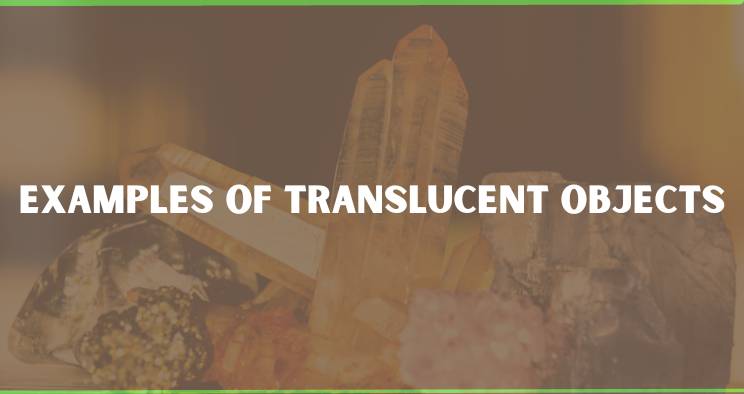Introduction of Translucent objects
Translucent objects are objects that allow light to pass through them, but not clearly enough to see distinct images on the other side. This is in contrast to transparent objects, which allow light to pass through clearly, and opaque objects, which do not allow light to pass through at all.
Examples of translucent objects
There are many examples of translucent objects in the world around us. Some common examples include:
- Frosted Glass: When regular glass isn’t shy enough.
- Sunglasses: Your eyes’ mysterious guardians.
- Ice Cubes: The cool, see-through friends of your drink.
- Bubble Wrap: Popping these is an art form.
- Shower Curtain: For your daily “Bathroom Opera.”
- Jellyfish: The ocean’s enchanting blobs.
- Lace Curtains: The windows’ stylish veils.
- Contact Lenses: What would we do without them?
- Beach Ball: Where’s that pesky seagull hiding?
- Hand Sanitizer: It’s like germ-fighting magic.
- Lava Lamp: A groovy ’70s throwback.
- Popsicle: Liquid sunshine on a stick.
- Ziplock Bags: Keeping snacks safe and mysterious.
- Paper Lanterns: Like tiny, glowing hot air balloons.
- Fogged-up Glasses: The morning struggle.
- Feather: A bird’s fashionable accessory.
- Candles: For your romantic “Moth’s Night Out.”
- Car Windshield: Your journey’s personal TV screen.
- Shampoo Bottle: Making your hair look extra important.
- Soda Bottle: Your bubbly, sugar-filled friend.
- Reading Glasses: Where’d my book go?
- Raindrops on a Window: Mother Nature’s tears.
- Cellophane: The clingy superhero of the kitchen.
- Shampoo: A bubbly, translucent lather.
- Saran Wrap: Because leftovers deserve a party too.
- Vaseline: The secret to glossy lips.
- Gummy Bears: Chewy, sugary, and see-through.
- Plastic Cutlery: Making picnics and fast food fancier.
- Airplane Windows: Where you pretend to be a pilot.
- Bamboo Screens: An eco-friendly room divider.
- Pineapple: A tropical, spiky delight.
- Scotch Tape: The hero of lost gift-wrapping battles.
- Lotion: Keeping your skin silky smooth.
- Crayons: The artist’s trusty companions.
- Plastic Wrap: Guarding your sandwiches like a pro.
- Champagne Flute: Bubbles make everything better.
- Gel Candles: The essence of candle aesthetic.
- Bathroom Glass Block: The fancier cousin of regular glass.
- Frosted Donut: Deliciously opaque on the outside.
- Bathroom Tiles: Your trusty anti-slip pals.
- Soap Bubbles: The ephemeral art of cleanliness.
- Wax Paper: For mess-free baking adventures.
- Nail Polish: A pop of color for your fingertips.
- Iceberg: Nature’s mysterious, massive ice cube.
- Hair Gel: The secret to perfectly styled hair.
- Glass Marbles: Miniature, mesmerizing globes.
- Shower Glass Door: The boundary between your sanctuary and chaos.
- Balloon Animals: Childhood’s squishy creations.
- Plastic Water Bottle: Stay hydrated, my friend.
- Cellophane Tape: When Scotch Tape’s on vacation.
Types of translucent objects
Translucent objects can be classified into three main types: solids, liquids, and gases.
Solids
Solid translucent objects are the most common type of translucent object. They include materials such as frosted glass, tinted car windows, sunglasses, wax paper, tissue paper, parchment paper, rice paper, cellulose wrap, cling film, plastic wrap, paraffin wax, beeswax, soap, toothpaste, shampoo, conditioner, shower gel, hand soap, dish soap, laundry detergent, all-purpose cleaner, glass cleaner, furniture polish, car wax, and sunscreen.
Liquids
Liquid translucent objects are less common than solid translucent objects. They include materials such as oil, vinegar, honey, maple syrup, molasses, corn syrup, icing, gelatin, agar-agar, pectin, xanthan gum, guar gum, carrageenan, isinglass, hydrocolloids, and emulsifiers.
Gases
Gaseous translucent objects are the least common type of translucent object. They include materials such as clouds, smoke, fog, and steam.
How translucent objects work
Light interacts with translucent objects differently than it interacts with transparent and opaque objects. When light hits a translucent object, some of the light is absorbed by the object, and some of the light is scattered. The amount of light that is absorbed and scattered depends on the composition and thickness of the object.
The light that is scattered by a translucent object is what allows us to see the object. However, because the light is scattered, we cannot see through the object clearly.
Applications of translucent objects
Translucent objects have a wide variety of applications. They are often used in decorative applications, such as frosted glass in windows and doors, stained glass, and decorative films. Translucent objects are also used in many functional applications, such as sunglasses, tinted car windows, privacy glass, greenhouses, solar panels, light fixtures, food packaging, and medical devices.
Translucent objects are an important part of the world around us. They are used in a wide variety of applications, and they have many unique properties. As technology continues to advance, we can expect to see translucent objects used in even more innovative and exciting ways.

